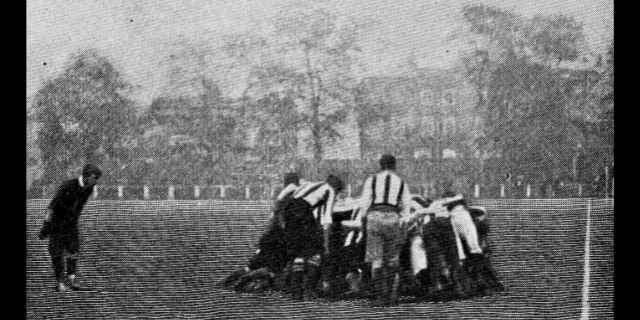If you’re wondering how many players are on a rugby team, then we need to establish which version of rugby you’re asking about.
There are at least ten different variants of rugby played across the world. They differ in both rules and the number of players and substitutes on a team. This article covers most types.
Numbers Of Players On Different Types Of Rugby Teams
The most popular version of rugby is Rugby Union with teams of 15 players on the field and 8 substitutes.
Rugby League has 13 players and 4 substitutes.
Rugby Sevens, an Olympic sport, has 7 players and 3 substitutes (with 5 players on the bench).
Other variants of rugby have different team numbers.
Here is a breakdown of team numbers by the type of rugby:
| Governing Body | Name | Field | Subs |
| World Rugby | Rugby Union | 15 | 8 |
| World Rugby | Sevens | 7 | 3 * |
| World Rugby | Rugby 10s | 10 | 5 |
| International Rugby League Board | Rugby League | 13 | 4 |
| International Rugby League Board | Rugby League Nines | 9 | 4 |
| International Rugby League Board | Rugby League Sevens | 7 | 5 |
| Federation of International Touch | Touch Rugby | 6 | unlimited |
| French Rugby Federation | Touch Rugby (France) | 5 | 5 |
| International Wheelchair Rugby Federation | Wheelchair Rugby | 4 | 8 |
| Informal | Beach Rugby | 4 to 7* | 3 to 7* |
Additional notes
There are some asterisks in the table that need further explanation. Let’s work through them.
The sevens version of the sport in Rugby Union allows three substitutes. But there can be five players on the bench. This makes for a squad of 12.
Touch Rugby is often played at social tournaments with no limit on the squad size or the number of substitutes. More formal tournaments usually apply a maximum number of substitutes to 5 or 6.
Beach rugby
Beach Rugby has no governing body. The number of players depends on the size of the pitch.
Larger areas can support seven players versus seven – and this is basically Rugby 7s on sand. However, smaller-sized areas often play with 4 players per team.
How Many Players Were On Historic Rugby Teams?

The oldest version of rugby is what we now know as Rugby Union, and was played in England and Scotland in the 19th century.
Back in the 1860s, teams had up to twenty players on the field.
With so many players on the field, the game was dominated by long periods of forwards pushing and shoving for possession of the ball.
There was a growing sentiment that the sport was becoming very unappealing.
The move to 15-a-side rugby

Renowned universities Oxford and Cambridge played a rugby match in 1875. They agreed to field 15 players per side.
In 1876, the governing body decided that international matches would field 15 players per team.
Even when limited to fifteen players, many teams in England and Scotland continued to field ten or more forwards.
However, Welsh clubs saw the benefits of having more quick backs on the field who could both break through gaps and pass the ball across the field.
Their success led slowly to the modern breakdown of eight forwards and seven backs.
Why Does Rugby League Have 13 Players Instead Of 15?

The sport of rugby in England split in two in 1895, primarily over the issue of payment of players. The side of the split known as Rugby Union would remain amateur for nearly a century.
The other side of the split started when twenty-one clubs in northern England formed what would become known as Rugby League.
Two of these clubs, Halifax and Leeds, proposed to the new association that team numbers should be further dropped from 15 to 13.
The Halifax club tabled the motion to a meeting of the Northern Union in late 1895. But the vote was lost by eighteen to nine.
Over the next decade, twelve-a-side rugby was becoming increasingly popular in social matches (i.e non-professional) in northern England.
In 1903, clubs voted in favor of a proposal to reduce teams to twelve players. The count was 54 votes to 23 but it still failed. The voting rules required a three-quarters majority for success.
1906: the year of thirteen
At the 1906 annual meeting of the northern clubs, the team size was kicked around again. Some clubs wanted twelve, and some wanted fourteen players per side.
But at last, a consensus formed around 13-a-side. The historic vote was 43 to 18, with the necessary three-quarters majority.
Why Did Rugby Union Allow Seven-A-Side Teams?

Let’s look at the development of the game in the late 19th century, before the split of Union and League.
A smaller number of players per team made it easier for clubs to arrange rugby tournaments over a weekend.
Smaller clubs often had to scramble for numbers for 15-a-side games and sometimes had to forfeit games. But it wasn’t so difficult to field 7-a-side teams at local tournaments
And as games with smaller teams had more running rugby and tries, these tournaments proved to be popular with spectators. Tournament organizers could charge spectators, with funds going to clubs and charities like local hospitals.
Some tournaments were played with ten, nine, or eight players per side. It was the seven-a-side version that gained popularity in Scotland in the early 1880s.
Melrose Sevens: the first rugby 7s tournament in the world
In 1883, two butchers from Melrose in Scotland organized a small seven-a-side tournament to raise money for their club.
This is considered to be the first 7s tournament in the world. The Melrose Sevens tournament is still held to this day.
The popularity of the sevens format spread across Scotland over the next decades.
Middlesex Sevens: the first big rugby 7s tournament in England
The English Rugby Union was antagonistic toward the smaller team size format.
Remember, the RFU was strictly amateur. They had some (reasonable) suspicions that the popular tournaments were paying back-handers to players.
However, they relented in the 1920s as the popularity continued to rise in Scotland. English clubs were simply traveling over the border to compete.
In the mid-1920s, tournaments started forming in England with official approval.
The Middlesex Sevens tournament in 1926 wasn’t the first sevens tournament in England, but it is still one of the biggest 7s tournaments in modern rugby. It started
Why Is Touch Rugby Allowed To Vary?
If you play Touch Rugby, you may encounter tournaments or social matches with six or five players per team.
The International Federation has standard rules, but it recognizes that social tournaments need flexibility.
They want to encourage participation and fun, and don’t want matches called off because one team is missing a player.
You will also encounter varying rules around the number of male and female players on mixed teams. And the French have their own version with different numbers.
I’ve written a separate article on how many players are on a Touch Rugby team – it goes into all these details.